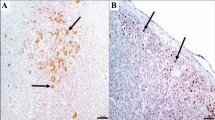Abstract
Localization of Newcastle disease viral nucleoprotein and pathological lesions was evaluated in tissues of 55 indigenous ducks (45 experimentally infected and 10 sentinel ones). In addition, ten Newcastle disease infected chickens were used to ensure that the virus inoculum administered to the ducks produced the disease in chickens, the susceptible hosts. Ducks were killed on day 1, 4, 8 and 14 post-infection. Post-mortem examination was done with six tissues (liver, spleen, lung, caecal tonsils, kidneys and brain) being collected from each bird. The tissues were preserved in 10% neutral formalin for 24 h. They were then transferred to 70% ethanol for histology and immunohistochemical staining. Airsacculitis, necrotic splenic foci, congested intestines, lymphoid depleted caecal tonsils and focal infiltrations by mononuclear cells were the main pathological lesions in infected ducks. Over 28.9% of the infected ducks had Newcastle disease viral nucleoprotein in macrophage-like large mononuclear cells in the caecal tonsils and kidney tubular epithelium. The viral antigens were located in the cytoplasm and nucleolus of the cells. The other organs had no detectable viral antigens. This study shows that the kidneys and caecal tonsils are the likely predilection sites for the virus in ducks. They thus need to be considered as diagnostic indicators for the viral carriage in ducks.

Similar content being viewed by others
References
Alexander, D.J., 2003. Diseases of poultry, (Iowa State University Press, Ames, Iowa).
Charlton, B.R., 2006. Avian diseases Manual, (American Association of Avian Pathologists).
Kim, L.M., King, D.J., Guzman, H.,Tesh, R.B., Rosa, P.A., Bueno, R., Dennett, J.A., and Claudio L. Afonso, C.L., 2008. Biological and Phylogenetic Characterization of Pigeon Paramyxovirus Serotype 1 Circulating in Wild North American Pigeons and Doves. Journal of Clinical Microbiology, 46, 3303–3310.
Kommers, G.D., King, D.J., Seal, B.S., Carmichael, K.P. and Brown, C.C., 2002. Pathogenesis of six pigeon-origin isolates of Newcastle disease virus for domestic chickens. Veterinary Pathology, 39, 353–362.
Kommers, G.D., King, D.J., Seal, B.S. and Brown, C.C., 2003. Pathogenesis of chicken-passaged Newcastle disease viruses isolated from chickens and wild and exotic birds. Avian Diseases, 47, 319–329.
Nakamura, K, Ohtsu, N, Nakamura, T, Yamamoto, Y, Yamada, M, Mase, M and Imai, K., 2008. Pathologic and immunohistochemical studies of Newcastle Disease in broiler chickens vaccinated with ND: Severe Nonpurulent Encephalitis and Necrotizing Pancreatitis. Veterinary Pathology, 45, 928–933.
Nishizawa, M., Paulillo, A.C., Alessi, A.C., Nunes, A.D., Campioni, J.M., Nakaghi, L.S.O., Doretto, J.L. and Lima, F.S., 2006. Study of experimental vaccination in white Pekin duck (Anas platyrhynchos) against Newcastle disease: Investigation of the state of virus carrier. International Journal of Poultry Science, 5, 786–788.
Nishizawa, M., Paulillo, A.C., Nakaghi, L.S.O., Nunes, A.D., Campioni, J.M., and Doretto J.L., 2007. Newcastle disease in white Pekin ducks: response to experimental vaccination and challenge. Revista Brasileira de Ciencia Avicola, 9, 1–4.
Njagi, L.W., Nyaga, P.N., Mbuthia, P.G., Bebora, L.C., Michieka, J.N., Kibe, J.K. and Minga, U.M., 2010. Prevalence of Newcastle disease virus in village indigenous chickens in varied agro-ecological zones in Kenya. Livestock Research for Rural Development Vol. 22, (visited on 16/05/ 2010) http://www.lrrd.org/lrrd22/5/njag22095.htm
OIE, 2008. Manual of diagnostic tests and vaccines for terrestrial animals, (World Organization for Animal Health, Paris, France).
Otim, M.O., Christensen, H., Mukiibi, G.M., Bisgaard, M., 2006. A preliminary study of the role of ducks in the transmission of Newcastle disease virus to in-contact rural free-range chickens. Tropical Animal Health and Production, 38, 285–9.
Roy, P., Nachimuthu, K. and Venugopalan, A.T., 1992. A modified filter paper technique for serosurveillence of Newcastle disease. Veterinary Research Communications, 16, 403–406.
Wakamatsu, N., King, D.J., Kapczynski, D.R., Seal, B.S. and Brown, C.C., 2006. Experimental Pathogenesis for Chickens, Turkeys, and Pigeons of Exotic Newcastle Disease Virus from an Outbreak in California during 2002–2003. Veterinary Pathology, 43, 925–933.
Acknowledgments
The authors would like to thank Mr. John Mukiri, Mr. John Muongi, Mr. David Gucema, Ms. Tove Dennman and Mr. Tony Bønnelycke for the technical assistance. Professor John E. Olsen, Prof. Birgitte Viuff and Dr. Joe M. Ayuya are acknowledged for their advice. Professor Ronald Iorio is highly thanked for donating monoclonal antibodies. This study was funded by the Danish International Development Agency through the ENRECA project ‘Productivity and health of smallholder livestock in Eastern Africa’.
Author information
Authors and Affiliations
Corresponding author
Rights and permissions
About this article
Cite this article
Njagi, L.W., Mbuthia, P.G., Nyaga, P.N. et al. Viral nucleoprotein localization and lesions of Newcastle disease in tissues of indigenous ducks. Trop Anim Health Prod 44, 747–750 (2012). https://doi.org/10.1007/s11250-011-9958-2
Accepted:
Published:
Issue Date:
DOI: https://doi.org/10.1007/s11250-011-9958-2




